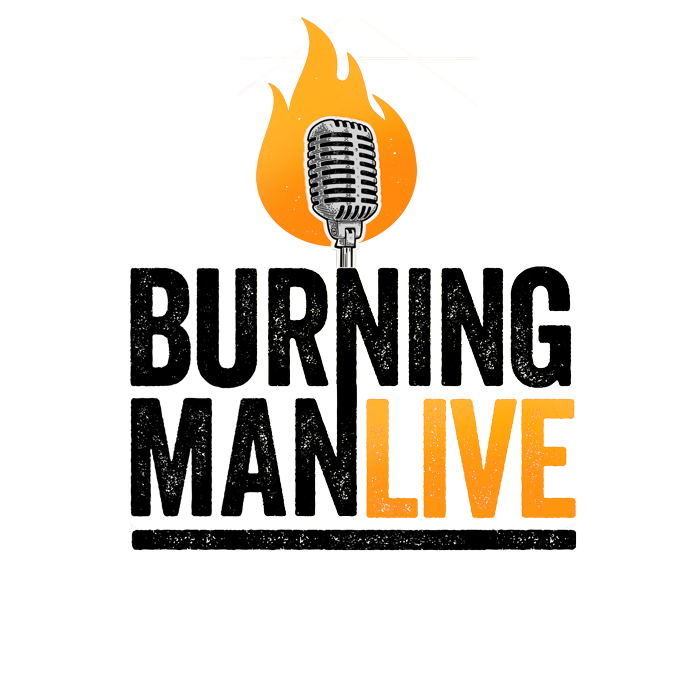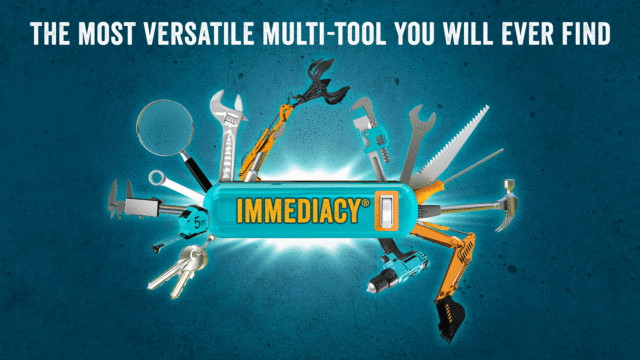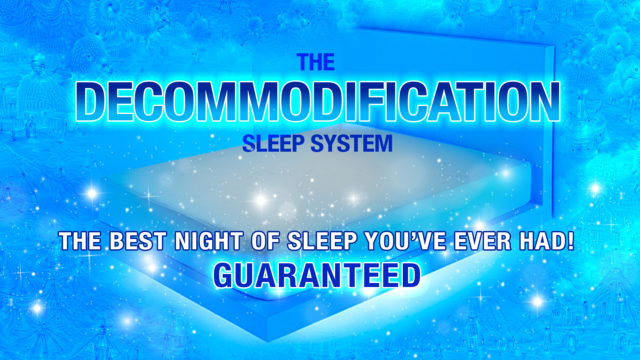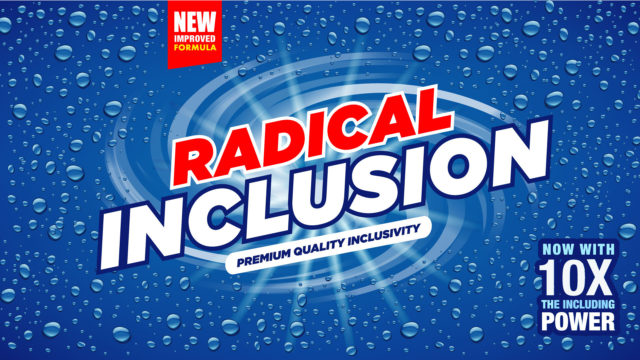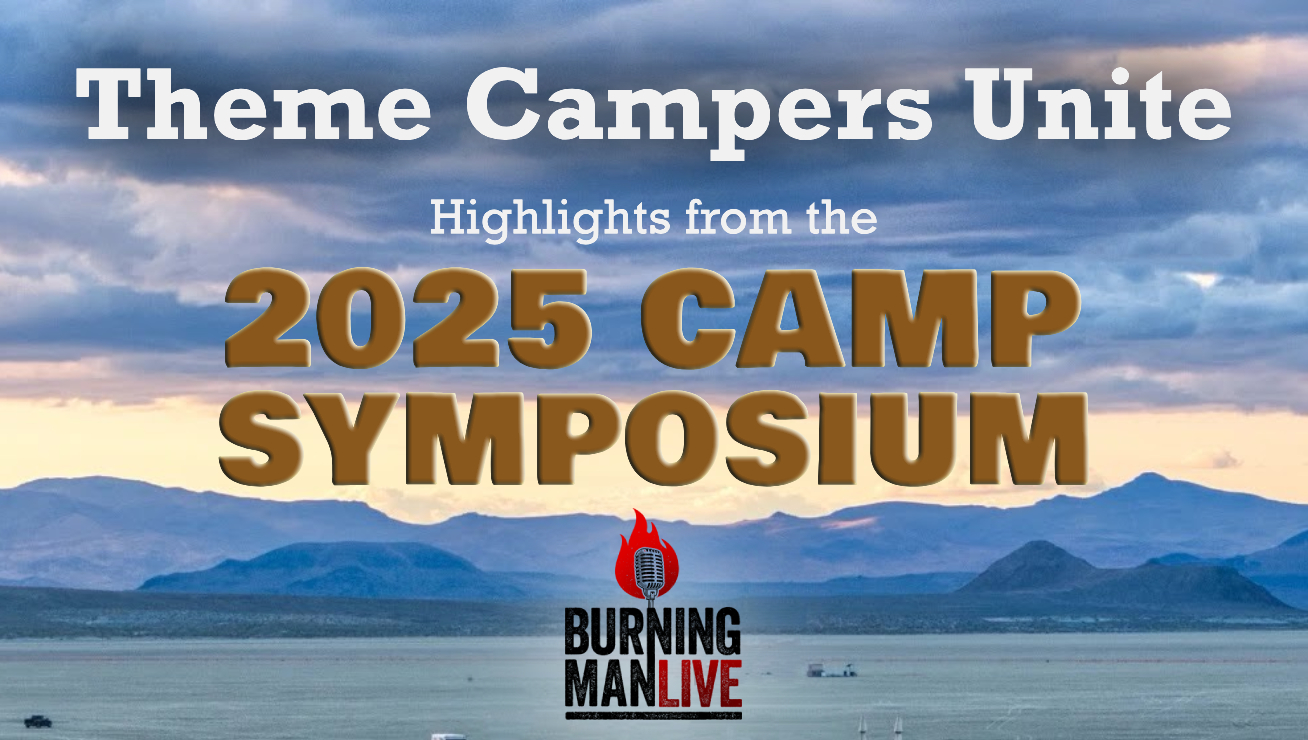
Theme Campers Unite
Most people in Black Rock City live together in placed camps, aka theme camps, the most unique aspect of this unique event. BRC has 1200 camps.
At the intersection of Communal Effort, Self-Expression, and Immediacy, theme camps gift a uniquely decommodified ‘third place’ of offerings and ambiance.
At this annual symposium, staff and volunteers share how they gift their interactive camps to participants. There’s an art and a science to it. These highlights are about the art of it.
- Bryant Tan (aka Level Placerman): head of Placement
- Andie Grace: Producer in the Philosophical Center
- Charlie Dolman: Director of Event Operations
- DA (aka Dominic Tinio): Environmental Restoration Manager
- Harley K Dubois: Founder & Chief Cultural Officer
- Stuart Mangrum: Director of the Philosophical Center
and a keen crew of Placement Team volunteers
- Bravo
- Cosmic
- Governess
- Hepkitten
- Huntress
- KGB
- Razzmatazz
Hear how it started, how it’s going, and how Burners create these unique and interactive passion projects.
Camps and Placement | Burning Man
Placement: About Us & Volunteering
Camp Support Team | Burning Man
De-bureaucratizing Your Burn (Burning Man LIVE 2025)
Charlie Dolman · The Dust is in the Details (Burning Man LIVE 2022)
Dark Angel of Black Rock & Restoration Destiny (Burning Man LIVE 2020)
Transcript
STUART:
There are lot of mass gatherings in this world that are not Burning Man. They have art, they have music, they have performances, they have everything you’d normally associate with the idea of a festival. But Burning Man events have something extra, something special. It’s also a big part of why the word ‘festival’ doesn’t really begin to describe what’s going on in Black Rock City, or in Pyropolis, or Tankwa Town, or any of the other temporary cities of the Burner-verse. I am talking about theme camps.
Somewhere at the intersection of Communal Effort, Gifting, and Immediacy, filling in a uniquely decommodified way the role that shops, and restaurants, and bars, and small businesses fill in a traditional city, what urban planners call the ‘third place’ — but with their spaces, their products, their services offered as a gift, not as a commercial enterprise; places for people to live, but also places to hold open house, to meet each other, to make new friends, renew old friendships, and knock each other out with the awesomeness of radical self-expression in its many, many forms.
Now, theme camps have been part of the Burning Man world since the event first moved out to the desert in 1990, inspired, I would say, by the Cacophony Society’s tradition of performative events, costumery, interactive shenanigans.
The camps have served as a way to bring us together, to open up our homes to each other in a sense, and to make the basics of living on a camping trip into something far more meaningful and fun and possibly weird. Now, I’ve been a theme camp organizer myself in Black Rock City off and on since 1994. I’ll be honest, mostly off, because I got to tell you, it’s a lot of hard work. It is a labor of love that will test you in a lot of ways and probably teach you some hard-won leadership lessons, which is why I have nothing but love and admiration for the people who are doing this and keep doing this, and why I try to help out every year when Burning Man Project hosts the annual Camp Symposium.
This is a free conference open to everyone who’s bringing or thinking of bringing a camp to Black Rock City this year. Whether it’s one of the thousand plus who go through the Placement process to get a reserved square of dust, or the countless others who opt in for free-range camping out in the city, it’s a full day of programming and a lot of peer-to-peer learning on pretty much every aspect of running a successful camp.
For today’s program, we built a little sampler of this year’s symposium content. Lots of expertise and some great speakers, including a few you may possibly recognize from this program. I think there’s just a ton of great advice here, whether you’re a big camp, small camp, placed camp, not placed, whatever. And there a lot more resources that people reference in these presentations. All the links are there for you in the show notes.
All right, here we go, campers! Our 2025 Camp Symposium show, starting now.
LEVEL:
I’m Level. I am the head of Placement for Black Rock City, and I’m excited. So 2025 is underway. I know that there’s been rumors out there like “Is Burning Man actually gonna happen?” Yes, it’s absolutely happening. Folks have bought tickets. We’re very busy planning, and really trying to find a way to get everyone who wants to be in Black Rock City back there.
I know the world is feeling really rocky and unstable right now. There’s so many things trying to vie for our attention, affecting our lives, and I do hope I’ve heard this through many spaces that there’s nothing more needed right now than Burning Man. And I hope you all believe that because the community that we build, the city that we build together, in the face of all the things that have been challenging, I hope you all feel inspired to come back, or come for the first time. I also hope you feel inspired today with all the lovely content we have for you.
And thank you to all of our moderators and panelists who will be speaking today to share your wisdom with the rest of the community.
So to welcome you, I’d love to bring on Charlie Dolman, our Event Operations Director, to also say hello to you today. Charlie, come on up.
CHARLIE:
Hi, Level.
So nice to see you folks here today. Thank you for taking time to come and be part of this community and help us move towards Black Rock City. I’m super excited to see how this year rolls out.
You know, yesterday, or last year, the theme for the event was Curiouser & Curiouser, but we have our kind of internal staff theme that we engage each year. And so last year, it was really about kindness. And we really leaned hard into it as an organization and as the teams and as the humans out on the ground, to slow down, to try to improve our interactions, to bring our best selves as much as we could to all of the conversations and all of the work that we did and all of the ways that we interacted together as a community. And I saw some really positive outcomes with that. I know it’s not perfect. We are all humans, but I do believe that we did make progress on that.
So how do we build on that, for today? Level mentioned that many of you will have hopefully seen or grokked, and kind of had little light bulbs come on that the Placed Camp Questionnaire has been adjusted, and there’s a fast track process, and simpler. Well, we’ve added other things in as well, because, believe it or not, we know that we’re bureaucratic, and we don’t want to be bureaucratic. And we’d love to be a little bit more human and to humanize the work that we all have to do to organize ourselves to get into Black Rock City.
So you’ve seen the Placed Camp Questionnaire. We have been doing similar work with the Art Questionnaire and with the DMV questionnaire. Some of that is on the ground, some of that is in the questionnaire, but it’s all like, where can we adjust and trim and streamline the process so that it’s less onerous and more enjoyable and more personal?
We’re also working on a lot of other things that we can do around the event. So we’re looking at Exodus traffic patterns. We’re looking at office hours so you’ve got access to staff. We really are looking across all of the things that we do to try to improve the experience and make it more human for everybody. Because what’s the future?
Well, we are leaning hard into being the change that we want to see in the world, and creating the world that we want to see. You know, we want the world to be thriving and connective and creative. And we know that you guys are the lifeblood of all of that. And so we should do our best to show up to that conversation in a way that supports you being part of that and for this community to continue to be awesome. So that’s what we’re doing.
I would love ideas. My email is eventoperationsdirector@burningman.org. If you’ve got ideas or thoughts, email them to me, and we can work together to improve Burning Man for everybody.
So I’m super excited. I used to be a theme camp organizer before I was this, and I remember how exciting it is to bring all the pieces together, and how important all of that stuff is on the ground in Black Rock City. So you guys really are the magic, and I appreciate you all. Thank you very much. I love you. Have a great day.
Back to Level.
LEVEL:
All right. Thank you so much, Charlie. Yeah. Theme camps really do make Black Rock City. I’m kind of like, what would Burning Man be without theme camps? It would be a lot of art that no one is there to enjoy.
Alright. So, we’re together here today as a camp community. What I wanted to do to kind of kick things off was to think about, what’s the history and legacy that we are continuing today with theme camps? As an organization, we’re doing a big effort, have been for several years, to try to document our cultural history of various departments, various groups. I would encourage folks, even in your own theme camps, I know some are just starting out, but if you’ve been around for a while, you probably have a lot of things documented. Maybe you don’t have a lot of things documented. But to do that because it’s important..
We’re going into the fourth decade of Burning Man and there’s new people coming to the fold all the time. And the question is, how do we continue that legacy? What is the importance of theme camps, and how do we continue that on?
So I’ve assembled a panel, a very esteemed panel, to talk about that.
So, we have Harley K Dubois, who is our Chief Cultural Officer. Hi, Harley.
We also have Stuart Mangram, the Director of our Philosophical Center here in Burning Man Project. Good morning, Stuart.
And we have Andie Grace, who is also part of the Philosophical Center.
So, hi y’all.
STUART:
Hello!
ANDIE:
Hi, everybody!
LEVEL:
Alright. First, if you just could introduce yourselves and say a little bit about your personal experience with theme camps, whether you’ve run them or just participated in them, or, you know, founded Placement and helped manage them. Harley, why don’t you go first, and then we’ll do Stuart and Andie Grace.
HARLEY:
Sure. I came up with Placement, and I came up with theme camps. 1994, we were debriefing after the event and I said, “Why don’t we line our circle (because that’s all we had at the time) with all those really cool camps that are doing really cool things, that are so artistic so that we can define our roads, or our spaces, in Black Rock City like we do in any city? Instead of everything stores, why isn’t it just creative art?”
So I actually managed the hotline at the time, this is before the internet. And every time somebody called me up and asked me about a rideshare or asking me about how to get a ticket or how to do this or that, the other thing I’d say, “By the way, what are you doing?” And I kept a list of all the cool camps. I said, “You sound like a theme camp. Do you want me to place you?” And then I just placed them around the circle, that was the only thing that existed, and started managing the process from there. So in 1995, I think we had 32 theme camps. ‘96, we had 50-some odd. And ‘97 we had a hundred, and it just kept doubling from there. So I’m one of the founders of Burning Man, I’m also the Chief Cultural Officer, and I’m happy to be here today. Thank you.
LEVEL:
Thanks, Harley. Wow. Calling in a hotline and registering your theme camp that way. I can’t even imagine what that’s like, if we tried to do that now.
Stuart, how about yourself?
STUART:
My first Burn was 1993, and there were some, I guess what you would call theme camps there, but they were very much in the Cacophony style of street theater, or you know, interactive performance. They weren’t any place that… there was no hospitality really, unless you count spoiled eggnog at Christmas camp as hospitality.
So in 1994, some friends and I put together what I kind of consider the first modern theme camp. It was Tiki Camp, where you could actually sit in the shade and have a drink and hang out with people. We did that for three years. Then in ’97 on the Hualapai, we did a bar village called the Neigh-BAR-hood, which I think kind of presaged Golden Guy Alley, if you will, on a much smaller scale. Then in the early teens, when I rejoined Burning Man, I participated in a camp called Campo Mysterioso. We did a great neighborhood bar over around 6:00, and made a lot of memories for a lot of people.
But what I’m really most proud of is that, in my role as education director, I was able to work with your predecessor, Level, with Answer Girl, with Retro, and you when you showed up. I think your first day on the job was the Camp Symposium at Gray Area.
LEVEL:
Yeah.
STUART:
But you old timers may remember that like 10 years ago, this event was very, very different. Talk about bureaucracy. It was a half day in the office, of pretty much every department, standing up and giving you do’s and don’ts — mostly don’ts — no knowledge sharing, no user-generated content. So I’m very proud that I helped evolve that event into this amazing thing that it is today. I’m very happy to be part of it.
LEVEL:
Thank you, Stuart, for planting those seeds. Things started with a phone call, and an in-person lecture, and look where we are today. A little different.
Alright, Andie Grace, can you tell us a little bit about your own personal history with theme camps?
ANDIE:
Sure. So in 1997, when my bandmates invited me to camp with them at the event, I helped to prepare the shade structure for Motel 666, which was essentially a bar in walk-in camping, and some shade and camping with clever writers. It was great, but not exactly high concept. It was wonderful, and it evolved into a lot of fun things, and there’s threads of it that are still alive today. Then I joined Gigsville after that. I did a theme camp of my own in about 2000 called Project X, and camped with them for several years.
And then when I started working for the organization, Media Mecca isn’t a theme camp, but it is a public-facing camp, so I dealt with the placement process for that, and have been in Center Camp for a really long time. And then last year I decided that I had too much copious free time and I missed, more directly missed engaging with Burning Man at a level that I wanted to try again. So I started a theme camp in Center Camp called Space Cats. We did karaoke, and we’re adding comedy this year.
LEVEL:
Oh, comedy. Not just karaoke.
ANDIE:
We gotta laugh these days! Am I right?
LEVEL:
Yeah. Need a lot more laughter, yeah.
You collectively have decades of experience in Black Rock City, and have seen sort of camps grow and then maybe fade away, and come back, or maybe not, or evolve into other things. I’m curious, can you just tell me a little bit of your favorite theme camps from the past that may not exist today?
ANDIE:
Well, I’m thinking back as far as I can, and I remember, I didn’t know what I was getting into when I went to camp with my friends at Burning Man. I had heard there was art. And then of course, spent a little time getting to know my campmates. And then there was that bike ride that we went on, and I ran into what was then, I guess I’m hearing about a hundred camps. I ran into one of those camps and somebody said, Ooh, ‘Flight to Mars.’ And I had no idea what I was in for. And you crawled in through this orifice kind of thing; there was a hidden ball pit that I think it took me till the second time to find. That was my first engagement with any kind of gift like that from a group of people to get together and do something so elaborate, and pre-ordained and created, with a concept. And it was so much fun. And we went back again and again. And there were other places. I see Bianca’s… Bianca’s in the chat.
You know, the idea that this concept existed was what showed me was different about this place from just going camping with my friends at any other time. For this Midwestern kid, maybe a carnival compared? But you paid for that, and this was being given away. And so that was when I really kind of grokked the heart of what Black Rock City really was.
LEVEL:
Very cool. Very cool.
Stuart, you mentioned that the kind of original theme camps were in the vein of Cacophony Society, like, performance. Ah, yeah. Do any of those stand out, or any others?
STUART:
There are a few that I didn’t get to see because they were before my time. There were what we would probably call theme camps now, before I showed up, as long as we’ve been on playa. There was the Modern Primitives who decided to paint themselves, smear themselves with mud, speak in a made-up language, and gave people their made-up coins. There was Miss Vivian’s Posh Camp, where she managed to maintain an extremely elegant lifestyle in the dust through some sleight of hand.
But personally, it’s my three years with Campo Mysterioso. I think we just created just a magical little scene there. It was very much, you know, it’s corny, but it was kind of like the Cheers neighborhood bar, where people, old timers, new timers, staff members, participants, could come there and make friends, in some cases make lasting relationships. In our second year, we had a couple who had been first timers the year before. They said, “You’re back! We met here. We got married.” Those kinds of intergenerational stories really, really touch my heart.
LEVEL:
Great. Harley, how about you?
HARLEY:
Well, my first year in 1995, placing camps, “Birthday Camp” was my favorite camp. It was your birthday every day, and they had presents for you every day. So it was just a cute, simple idea, but it just sort of tickled me.
I think one that’s worth noting from the past was from Portland Cacophony’s Disgruntled Postal Workers, who created their own outfits or went to thrift stores and found postal worker outfits. And they had real guns on their backs, like big rifles on their backs. It was a little scary to me because I’m not a gun person, but no judgment, um, and they were okay at that time. But they were disgruntled and walked around camp and were very funny, very funny — if you weren’t threatened.
But I just had to make a plug for my own camp. I never did a theme camp. And I started my own theme camp, it’ll be my third year now, called Playa Paul’s Concierge Services. And all of you guys should come by because it’s really a learning opportunity for what not to do at Burning Man. But it’s one big joke, just one big joke. That it’s totally in the spirit of Cacophony and the early days, where you’re going to be challenged a little bit, but it’s going to be funny! And you’re going to enjoy it. So please come by Playa Paul’s Concierge Services.
LEVEL:
You know what’s also funny, I dunno if everyone knows this, but we have a DoingItWrong@burningman.org email address where people get to like write in and say, “Oh, there’s this plug-n-play situation, or these people are doing it wrong.” We actually got an email saying Playa Paul’s Concierge Service was doing it wrong. People were like, “They’re renting out Segways! WTF!” So, good job, Harley.
You know, part of why I wanted to pull this together and talk about history is, I feel like when new camps now discover Burning Man, or want to participate and build a theme camp, they have like preconceived notions of what that should look like because things have changed. The flavor of theme camps today that are starting out might be different than it was in the past. With this line of fun, jackassery, making things unique, how would you recommend people do that, and what enabled that in the past that you think we could bring back more or see more of in today’s Black Rock City?
STUART:
All I can say to this, Level, is: Embrace the change. We forget so easily that it’s a fresh palette every year. And I think there’s a tendency to, particularly if we have a successful camp and a successful year, to say just keep doing that same damn thing, and grinding it into the ground, when there are so many opportunities to mix it up, to rethink your interactivity and to refresh your crew.
It’s a natural process for camps to split, to mutate, to, you know, spawn other camps, to embrace that and not try to fight that. Right? And to just realize that each of those people who are taking it out into their own experiences, they are learning great skills. You know, they’re learning logistics skills and learning leadership skills. And the more people we have in our community who have that level of leadership, the more effective we’re going to be and the longer we’re going to last.
LEVEL:
Great advice. Andie Grace, I see you nodding a lot, so I’m going to pick you next.
ANDIE:
I’m really agreeing with the evolution thing, and sometimes you can get so high concept, I’ve referred to that high concept, but sometimes you can get so married to that experience over and over that we forget to go out and enjoy the city. We get ourselves into stressful relationships with a cohort. We just get burnt out. You know, one of the reasons I tried to shake it up last year.
I’m thinking back again into the deepest parts of history, and my husband’s first theme camp, Tom Price, he camped with Camp Sunscreen. Other than having a place for people to be sunscreened. There’s not a lot of high concept there. You bring a bunch of sunscreen and you help people stay safe from the sun, and you’re going to meet new people, you’re going to work together to cover the shifts. It’s very simple and a great way to engage.
I think as we’ve evolved through our years of ticket scarcity and how theme camps came to represent our connection to that, and now we have a little bit more ease in our room and we’re getting to invite new friends, that keeps things alive and you have to be not afraid to evolve with it and have fun.
LEVEL:
Thanks, Andie.
Harley, any thoughts about just how people keep things interesting and keep jackassery alive?
HARLEY:
Well, jackassery is tricky because when it’s done well, it’s beautiful and it’s really fun and people can actually hear things that they couldn’t hear otherwise, but it’s being presented to them in a joke. And that’s a beautiful tool. But it also can so easily slip into something that’s just uncomfortable.
And frankly, for me these days, there’s so much change in the world that I just feel like the younger people are going to bring something new, and it’s going to be different than what we’ve experienced before. And we have to just be really open to it and embrace it because I feel like it’s time to refresh.
Burning Man is a sacred space to me, in that you can really go there and be yourself. And I want to see how people are being themselves that are younger generations than me. I’m 62 years old, and so I’m really curious to see what comes next, what’s different. And I want to be delighted like I was the first time I went again, which I am, every year. I’m always delighted, but I’m looking forward to seeing the change.
LEVEL:
That’s really important to hear coming from our Chief Cultural Officer that it’s not just about keeping that old flame alive, but really being open to new.
Thank you all for this lovely conversation. I hope everyone joining us and listening in that you’re a little bit more inspired. You know, Placement often says, just bring what you can, do what you can, with the resources that you have, and make it interesting, make it unique. You get to choose your own adventure. Our predecessors did that, and we’re going to continue doing that in 2025 and on.
So thank you, Harley. Thank you, Stuart. Thank you, Andie Grace.
Thank you, everyone, for sharing your rich, rich knowledge with each other. It’s important for us to share as an organization and as the Placement team, important announcements and perspectives. So, hope you all will stay with us.
About a little over half of you are the main camp lead or organizer. Thank you, thank you for all your many, many hours of work. I know it takes a lot. I heard in one of the breakout sessions, it’s not herding cats, it’s hurting squirrels. So thanks for herding all the squirrels. And Burning Man wouldn’t be the same without all the veteran organizers that have been here for over a decade.
A lot of the times of why people love the Camp Symposium is just meeting other camp organizers. Who knows what kind of things you might be able to spark with each other. I hope you all made a connection, or maybe you saw an old friend that you haven’t seen since the playa.
So we have folks today, actually, my beloved Placement team. I’d love to bring together six of them who are here today. If you have joined our office hours that have been happening monthly, many of them show up there. I know some of you have only an email relationship with them, and so hopefully this gives you a sense, a better sense of who they are.
The Placement team is a fully volunteer team. They spend nine months out of the year, really working hard, thinking about how to best serve you, think about how to make our process go more smoothly, and are putting in a lot of volunteer labor.
So, I know, a lot of times you’re like, “Whoa, they’re making us do all this work! Can’t they see how much work we’re doing?” We see you. We all see you. And, there’s a lot of work they’re doing too. Every word that you write has to be read by at least three or four people. So just know it’s not going into a black hole.
Let’s go ahead and just do a quick introduction about your name, and the sector that you are working in, and maybe one thing you love about your sector.
I’m gonna go ahead and start with Governess from 2:00 and 10:00.
GOVERNESS:
I’m the Governess, I am the lead Placer for 2:00 and 10:00, and, gosh, so many things I love about the sector. I like the diversity of large-scale sound stuff, plus all of the amazing other camps that form part of the sector, because I think it makes it really interesting and lots of different things happening there.
LEVEL:
All right. Let’s move on clockwise to 3:00, KGB.
KGB:
Hey, everybody, KGB, I’m the lead Placer for 3:00 this year, and I was dragged to Burning Man in 2007 by The Magpie. One of the things I love about 3:00 is that it was where I camped for my first three years at Burning Man, and it feels like home.
LEVEL:
Awesome, right. Moving right along. We will go to 4:30 with Bravo.
BRAVO:
Yeah, Bravo. I’m the 4:30 sector lead this year. And, what I love about 4:30 is there’s a lot of smaller camps that are really fun, and they really make the streets great. A lot of interactivity between them across the streets, and so forth. It’s really a fun time. So, yeah, love 4:30.
LEVEL:
Thanks. Bravo.
Hepkitten is in a new sector this year. I’d love to get Hep to introduce yourself.
HEPKITTEN:
Hi, I’m Hepkitten, and I am in 9:00 this year. So far I’m not super familiar with 9:00, which I am very much looking forward to getting to know all the 9:00 camps, but I can’t tell you from 6:00. I love the dedication of all the camps and the diversity of all the camps and um, how much you put up with the departments and don’t complain. You go to the easygoing sector, and I love that.
LEVEL:
Awesome. Thank you. All right, let’s move on to 7:30, Cosmic.
COSMIC:
Hey, everybody. It’s Cosmic, 7:30 Placer. I started going to Burning Man in 2010, and I love the connectedness of community in 7:30. There’s people that have known each other for years and years, and they all hang out all year. It’s a very, very tight-knit community that take care of each other, and it’s just full love. So I love it.
LEVEL:
Amazing. All right. And we’ll wrap it up with 9:00, Huntress.
HUNTRESS:
I am Huntress. I am the lead Placer for 9:00 this year, which is the only sector I have ever lived since I started coming to Burning Man in 2012. So I love it because of familiarity. But also, yes, there’s always a party, but I think 9:00’s deep commitment to snark and shenanigans will have my heart forever. And I’m excited to be back this year, and to see many familiar and new faces.
LEVEL:
Thanks everyone.
So we’re not going to have a chance for every single Placer to answer each of these questions, so we’ll try to get a couple of perspectives on each.
A question that we get a lot as a team is: What are you looking for? When you’re designing your neighborhood, when you’re figuring out which camps go where, what are the things that stand out to you as a Placer? What are the things that you kind of highlight and think about when you’re doing that mapping?
BRAVO:
One thing I would say is variety. I always feel like somebody who’s camping on a particular block or street should be able to, if they wanted to, they could stay in their neighborhood for the entire Burning Man and have a wonderful time, and never even have to venture out. I want them to venture out, but there needs to be a good variety of things happening on every day, different times of day, so that it’s never boring. So, you know, bars are okay, but you can’t have an entire street of bars. It’s good to just have a whole variety of different things.
LEVEL:
Alright. Variety.
Hepkitten.
HEPKITTEN:
I’m always interested in seeing things that are unique or rare, and less common, and experiences that you can only get at Burning Man, and things done really well. So I love seeing bars, but especially when they’re done really, really well, and they have like a unique twist to them or a different twist to them than just, you know, the regular same old, whatever.
So, something different and new, and also something that’s pretty is always good, especially when it’s lit up. I always like to try when I’m working on maps and stuff, to look for camps that will draw you down the sector further, until before you know it, you’re like at the back of the city going, “How did I get here?” And it’s just because you were having fun seeing something and wandering.
LEVEL:
Yeah. Uniqueness. Our panel with Harley, and Stuart, Andie, they mentioned that original theme camps sometimes we’re just like these performance experiences that you could only get out there, and so, that kind of leads me to my next question. We get asked all the time: How do you make something more unique? If you’re offering a more common thing like a bar, do you have any advice about how a camp could turn their interactivity from just a same-old same-old to something that would stand out?
Cosmic.
COSMIC:
Yeah, I would give an example of that. So a bar is a bar, but if you wanted to do that, look for something unique within your community, in your theme camp. So an example would be Deaf Granny’s Kitchen, which is mostly deaf campmates, and that’s their community. They do bring a bar. They’ve got a DJ. They do some of the same activities that other people are bringing in, offering a bar and DJs and dancing, but they’re doing something that is part of their value set within their camp. And they’re also using it to teach people other Burners ASL, so you don’t just come up and get a drink. They’re using sign language to teach you, so you become part of what their community is.
Because they’re offering this to everybody in the community for learning, interactive, it makes it unique. I love that they bring this to Burning Man. And it’s very challenging for them. And every year that they come, they get more and more people involved with sign language. Now we have another smaller camp that is sign language who wants to come in to 7:30 because they went, and were near them last year, and went into their camp. It’s neat to see the synergy happening. So, that’s an example.
LEVEL:
Great. Does anyone else have an example or a tip that they might offer? Huntress.
HUNTRESS:
What I always am looking for is even if it’s a simple idea, something that takes the commitment and the passion of the campers into mind.
So I have friends who had a martiny, a martiny bar. They had martinis in tiny, tiny shot glasses with a caper instead of an olive, and you had to suck on helium before you could get a drink. They’re experiential and connective, in addition to just going to a bar and ordering a drink. You’re being asked to participate in whatever this experience that has been created.
I think similarly, but in a different aspect, you can have a coffee camp. Kaleidoscope, which has been in the 9:00 B Plaza, I believe they roast their own beans. So they do something, and they do it very, very well and with an incredible amount of thoughtfulness. It doesn’t have to be shiny or bright or enormous, but you get an incredibly good cup of slow-pour coffee. They’ve spent a lot of time, and you have to wait for it. You’re asked to participate, even as you’re being gifted something in return.
LEVEL:
That’s great.
Bravo.
BRAVO:
Theme camps are art, right? It’s your art, the thing that you’re doing. It’s something you’re excited about. So, whether you want to bring a bar or bring coffee or bring yoga or bring something else: What are you excited about? What is your theme? What is your camp really behind? Because it doesn’t matter what your base is, it’s really what you’re putting on top of it.
“I’m having a birthday party with my friends.” No, “I’m having a Studio 54 party,” right? It puts more fun on to it, adds more costumes, and it doesn’t really matter what that bottom layer is. It’s that interactive aspect to get people excited, and part of it that’s really important. So as long as you focus on that piece, it doesn’t really matter what you’re doing underneath it, because people will be excited, and it’s a big city, all these people are going to want to come in and interact with you and your camp.
LEVEL:
Yeah, I think about engagement versus transaction. In a lot of places in the default world, people go to a bar because they, the point is to get the drink, and to get sloshed or something. The point in Black Rock City isn’t necessarily about getting that drink. It’s about that engagement and the interaction that you get, and the process of that. And some of my favorite experiences are just that, like, wow, they made me like, solve this puzzle before I got what I thought I came here for. And now I have a new friend. Or now I have a new idea sparked about how I can do my thing differently.
There also are questions about, what do we wish we saw more? Sometimes we’re still looking for something. What is that camp? What is that interactivity? What is that experience? KGB?
KGB:
The thing is that everybody in their neighborhood wants a bar, and they probably want to find coffee somewhere, and they probably want a yoga, and just the sort of things that make life better. But then the thing that we’re looking for, I think, is to mix in things that nobody would have thought of before. It’s not a bar, it’s some sort of jackassery, it’s a game you have to play; it’s just something unique. We don’t want everything like that, and nobody can find any coffee anywhere. But on top of those luxuries of life, think of something that’s just weird and unique.
You know, like, I’m drawing a blank on their name, but you pick out your stuffed animal and then you make a party pole out of it, and then you dance around with your party pole. The whole process of adopting the thing, and then they do surgery on it. Where are you going to see that outside of Burning Man? You can go to a coffee shop or a bar outside of Burning Man, but where do you get to adopt a stuffed animal and make a party pole out of it, and then party with your party pole? That’s unique.
LEVEL:
Thanks.
Cosmic.
COSMIC:
One thing I just love, as a personal thing, and I love seeing it at Burning Man and interacting with it, is the live performance shows. It’s hard to do it on playa, but when you get a small camp, like a 50-person camp, and it’s live performers, I just love that. If you can come in and watch, and be part of the audience of performance, live performance. What we haven’t had a lot of is live comedy, these type of live events. We do have a live comedy camp at 7:30 in G Plaza that has successfully brought it and done it, and people are really enjoying having that interaction with the camp, and they’re doing workshops as well. And so it’s great to see the comedy coming, and I just love to see the live performances. I feel like we have an untapped pool of this in our community that I would love to see more of.
LEVEL:
All right.
Bravo.
BRAVO:
Yeah. Where are the goat yoga camps? That’s what I’m looking for! I want to do some goat yoga at Burning Man! They have some people dress up as goats. But now I’m just joking, right?
In general, all of us Placers have the things we like. I might like something more or someone else might like something, but we don’t just take that and be biased. We just want to make sure the theme camps know that we want you to do something that you’re really excited about, right? We don’t want you to phone it in. We don’t want you to try to think of, “Well, what does Placement want this year?” Just do something that you’re really excited about. Or if you’re doing something that you think might not be super unique, just do it, just do the hell out of it, and be really excited and passionate about it. And that’s the most important thing.
Ultimately, the city’s built by everybody and the community and the neighborhoods are built by the theme camps. So the more exciting things you come up with, the better the city is going to be, and the more fun all the participants are going to have.
LEVEL:
We often get the question of, like, “What does Placement want to see?” and I always try to turn that back to “What does the community want to see?” Ultimately, our team is stewarding all these questionnaires and really trying to understand that, to create neighborhoods and communities. But if you feel like something’s lacking out there, if you’re going through any part of Black Rock City, and you’re like, man, I wish this was in this part of town, maybe you could be the change that is that thing. Or maybe you can encourage other folks that are Burners when they’re talking about this. So it’s less about, I think, what Placers and Placement want to see, and more about what you want to see and what you think your friends want to see. Hold that in your minds as you’re thinking about it.
And you know, Stuart mentioned earlier, try something new. I know there’s a lot of tried-and-true things, and things that go well, and that takes many years to nail down. It doesn’t mean like add a thousand lasers to your camp, but what can you tweak around how you create that experience for people? Those are the kind of the things that we’re looking for.
I want to thank my placers for joining us today. And thank you for all your volunteer service.
Next up, as people are wondering, what kind of interactivity is out there, we want to give you more of a stats presentation about what we see in the Placement Questionnaires. So I’d like to invite up Razzmatazz, who is a Placement Data Support volunteer, joined us for the last couple of years. And Razz, take it away.
RAZZMATAZZ:
Thank you. Level.
Hey, everybody. I’m Razzmatazz from Placement Data Support. And I’m here today to discuss the dust in data.
The first question is: How many camps were placed last year?
So this is including both theme camps and art support camps and, you know, all sorts of camps.
LEVEL:
We get about 1200 theme camps overall.
RAZZMATAZZ:
Over the last couple of Burns, these numbers have been pretty flat, as the city has filled out, and we’ve considered some of the trade-offs between more placed camps and more open camping.
We have also seen the rise of HUBS over the last few years. The number of camps participating in HUBS is growing increasingly every year, since the program was first launched.
And now we’re at about 20% of camps are in a hub in some way, shape, or form, which is very exciting as camps share resources.
How many people are in each camp?
This is one of the big questions I had when I was joining the Placement data team.
I was pretty surprised to find that, over the last couple of years, like, over two-thirds of camps are below 40 people.
I think we hear a lot of stories about the big camps. As somebody in a small camp, I think it’s good to see that I’m in good company.
When is the city most alive? When in the week are camps hosting different events?
In looking at these numbers, I see mid-week, and like, around the afternoon, are when a lot of events are occurring. Maybe this is inspiration to do some things, you know, even earlier in the week or even later in the week, in order to continue to have the city be active and more alive throughout the entire week.
Looking at what camps are doing.
Comparing 2023 and 2024, we actually have more bar camps, by percentage, are camps offering some sort of bar. Another interesting point is we also see a very large rise in the number of camps, you know, that maybe have a normal bar, but also are offering nonalcoholic options. And I think that’s really great for the folks that come to the Burn that do not drink alcohol.
We also see an increase in the number of camps doing DJ or dance-type events throughout the week.
Things that have trended down over time.
We actually have fewer camps doing live music. So maybe that’s something that your camp is doing, and you can champion that even more, and maybe more camps still consider doing live music. Especially, you know, as some of the Placers said, if you’re really excited about live music and think that’s a really important part of your Burn.
We see fewer camps providing food in the form of full meals. Now, we actually are seeing an increase in the number of camps providing snacks, and like smaller quick bites to eat. But definitely, I can speak to my personal experience of enjoying a good playa meal that’s hearty, and you know exactly what I need, maybe in the middle of the night, maybe after dancing all night.
And then, finally, something that kind of surprised me about the data. In 2024 we started tracking how many fitness and gym camps there are, and we found that there were 16 of these. Perhaps this is not how I want to spend my Burn, but I’m thrilled that there are people excited about this. I think it’s super cool that 16 camps have figured out how to make this actually happen out on the playa.
That’s everything for me. Thank you so much, everybody. And back to you, Level.
LEVEL:
There is a lot of data, every form that gets filled out can turn into some bars and graphs. Thank you Razzmatazz. You really helped level up our ability to explain all the information that we sit on.
And one kind of anecdote we did ask: what is a playa meal? Is a hot dog a meal? Is it a snack? I don’t know. So that’s the challenge with data categorization, but we did our best. So thanks, Razz.
All right, we have one final presentation in this parade, and it is from a fan favorite: DA of Black Rock City, our Playa Restoration Manager. I’ll hand it over to him, and that’ll wrap our parade. So DA, take it away!
DA RESTO:
Hey, gang, I’m DA, Playa Restoration Manager.
Let’s go over the Leaving No Trace principle.
“We are committed to leaving no physical trace of our activities wherever we gather. We clean up after ourselves and endeavor, whenever possible, to leave such places in a better state than when we found them.”
Now we’re going to talk about MOOP, a word in Burner culture that stands for Matter Out Of Place. MOOP is anything and everything that isn’t natural to the Black Rock Desert environment. The Black Rock Desert is nothing but dust. Therefore, MOOP is everything. Leave no trace.
So, worst MOOP in BRC 2024 countdown, here we go.
#3. Wood debris. This is your sawdust. This is your firewood. This is lumber. So, make sure you get all of that up.
#2. Plastic debris. This is your zip ties, bottle caps, packaging, glowsticks, connectors, garbage bags, etc.
Now the number one MOOP: Lag bolts, tent stakes, rebar.
Just to show you how we’re trending:
- 2019, we had 100 lag bolts.
- In 2022, we had 1000.
- And in 2023, we had 1500.
We’ve been raising the alarm, and yet in 2024, we still had approximately 1500. Everybody seems to be missing a few here and there. Divide that amongst the population, and we’ve got like 1500, which we need to really improve on. This is super important.
And here is the rest of the list: Tent stakes, cardboard, cigarette butts, plant matter, food debris, burn scars, paint chips, and fireworks.
My team, it’s like 150 people out there, covering all of the Black Rock City. The BLM’s MOOP standard for Burning Man is one square foot per acre. One square foot per acre. So if you can imagine, an acre is 43,560 square feet. Or imagine a football field. Now imagine a square foot, and then now you’re talking one square foot versus that football field. And by the time that Resto’s happening, MOOP is averaging about a quarter of an inch. So everything comes down to debris, which is why we use that term. And that’s the term that is actually in the BLM inspection.
Black Rock City is over 3700 acres, so that’s like 3700 football fields, or 157 million square feet. And that’s why your cleanup effort means the world to us.
The BLM inspection is conducted one month after the Burn. In 2024, we passed with flying colors. Also, the BLM added a new part of the inspection where we were not allowed to fail 10% of the total 120 test points. Now we can be under one square foot per acre, but if we get over this, we fail. It was really important for us to bring it down, which we did this year. We brought it down to three. So, great job everybody!
And yes, that’s great, and Black Rock City, we can always do better!
- Do pull out those leg bolts, stakes, and rebar. Tag them, mark them, and account for them.
- Do seven-minute daily camp MOOP sweeps. The more the merrier. And it goes so fast, and it’s super easy, arms-width apart across the camp width, so make sure you have enough people.
- Do daily camp MOOP maps. When you’re doing your MOOP sweeps, do your MOOP map. Start drawing on it. Start marking the areas that are trending; the areas like your bar, the burn barrel, the showers. Wherever you’re starting to find that MOOP where it’s slowing you down, color it red, color it yellow. Just start getting an idea of it and keep it for your records.
- Do MOOP test your camp!
- Do remove all flags. It is so helpful. We would really appreciate that. There’s thousands upon thousands of flags in Black Rock City. When you grab your handful of flags, that is a huge help, because multiplied by the entire population, all those flags are gone, and that way my team can focus on the MOOP.
So Leave no Trace. Thank you, Black Rock City. Join Resto September 15th to October 2nd. restoration@burningman.org. I’ll see you on the playa.
LEVEL:
Thank you, DA.
Thank you, everyone from Burning Man Project and the Placement team who presented this last hour. I know it’s a lot of information, but hopefully that makes everyone that’s on the call feel more equipped about getting out to Black Rock City.
You should never be afraid to email placement@burningman.org. We are always here to answer your questions and point you in the right direction. So email us, come to the office hours, review the stuff that we presented today. I hope this has been super informative for all of you.
I do want to acknowledge our planning team. It takes a whole volunteer team many months to pull this together. So I’m going to name them: Andrew, Dustin, Griffin, LL, PETA, Huppie, Siobhan, Redbird Bean, and Vespervel. These folks have been hard at work for many months to make this happen. Thank you, thank you, thank you.
VAV:
Michael Vav, here, the producer of Burning Man LIVE. This episode was a composite montage collage of clips, from the Camp Symposium held in March 2025.
Big appreciation to you, yes you, for listening. Burning Man LIVE is a passion project of Burning Man Project. Our mission as a non-profit? We facilitate and extend the culture that emerges from Burning Man events into the larger world, fostering community, art, self-expression, and civic engagement, and upholding the 10 Principles of Burning Man.
One way you can help is to go to donate.burningman.org, click on the DONATE button, and pledge some fun amount, like 1-2-3: 123 dollars, or 12 dollars and 3 cents, or 1 dollar and 23 cents. Every little bit helps.
Thanks to Level Placerman and my podcast teammates Andie Grace and Stuart Mangrum (as well as kbot and DJ Toil). Thanks to Harley K Dubois, DA of Black Rock, and the Placement folks who gave their time and attention to the many theme camp producers who participated in that symposium.
And, thanks, Larry.
more

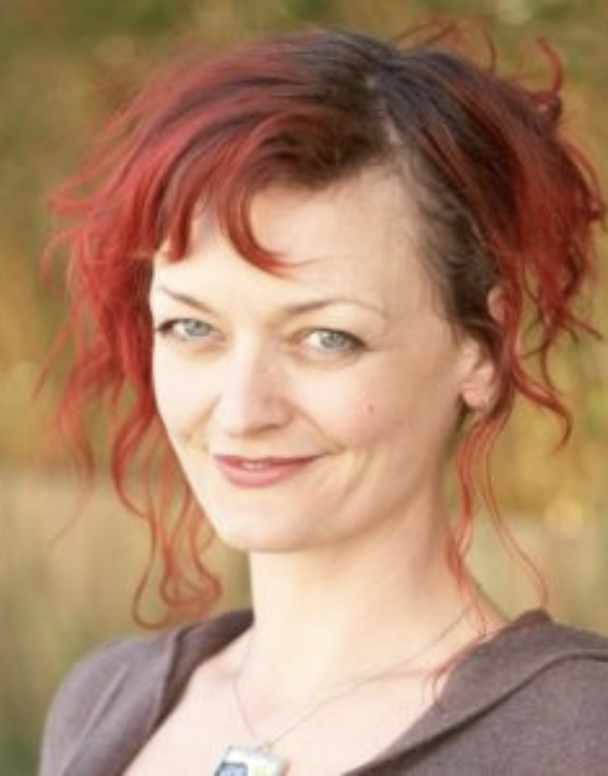 Andie Grace
Andie Grace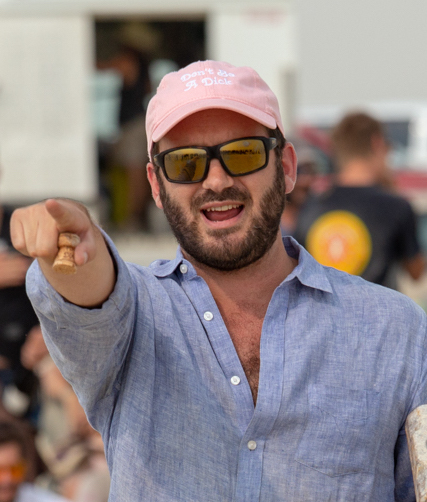 Charlie Dolman
Charlie Dolman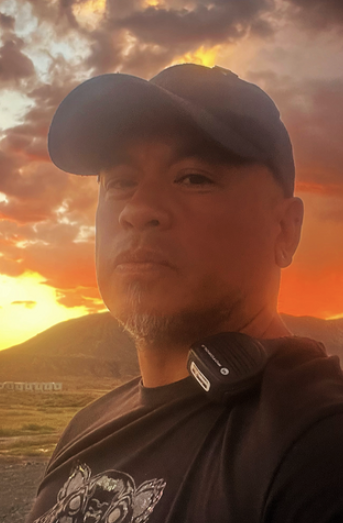 DA Dominic Tinio
DA Dominic Tinio 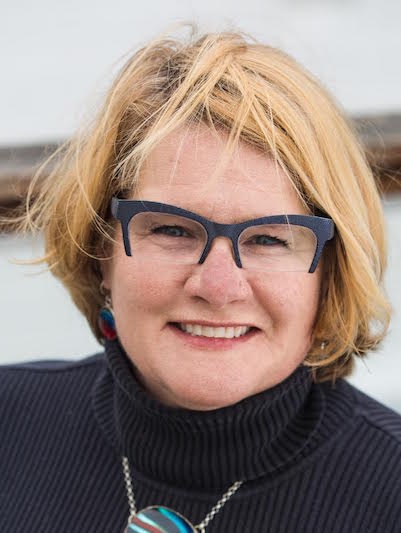 Harley K Dubois
Harley K Dubois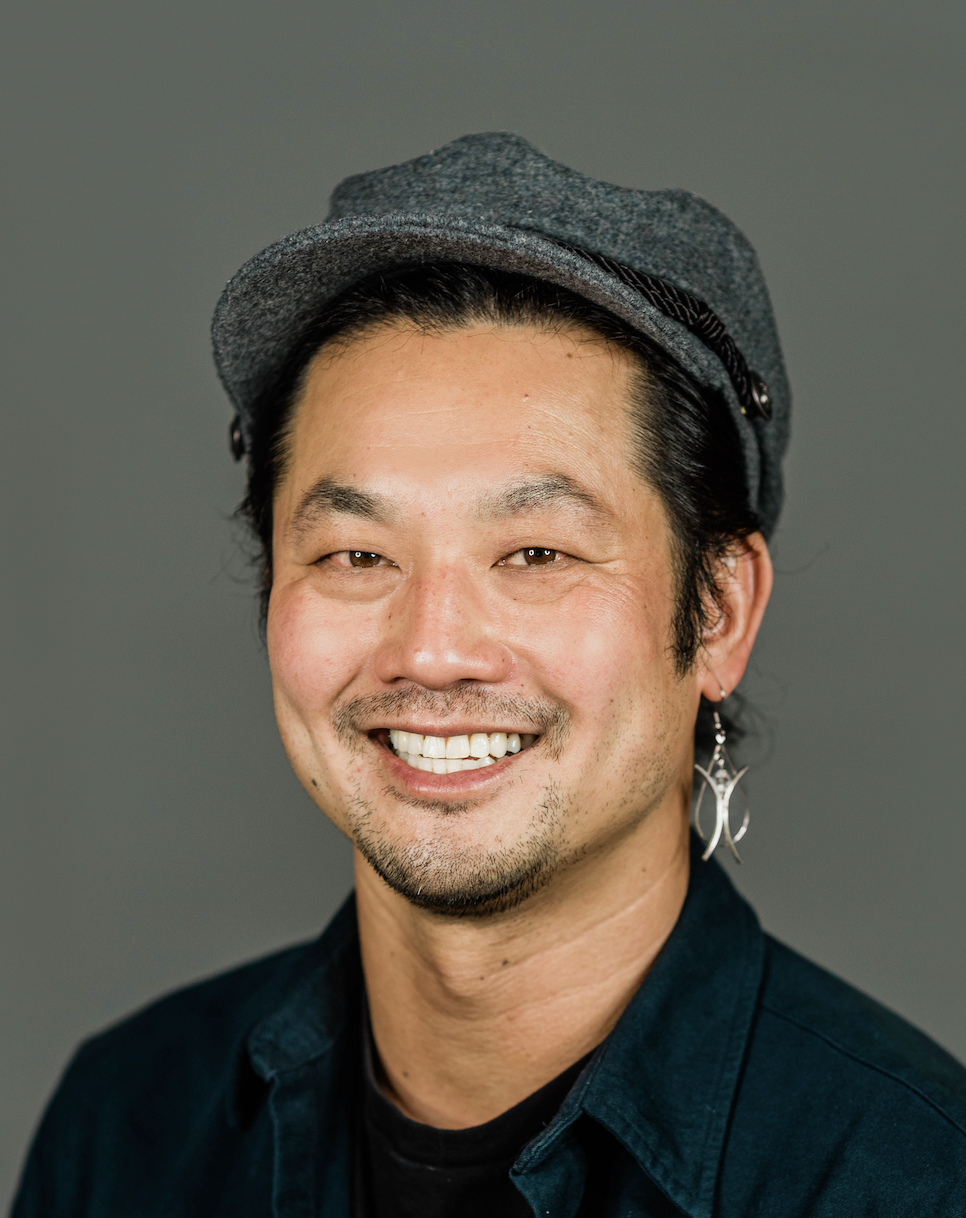 Level Placerman
Level Placerman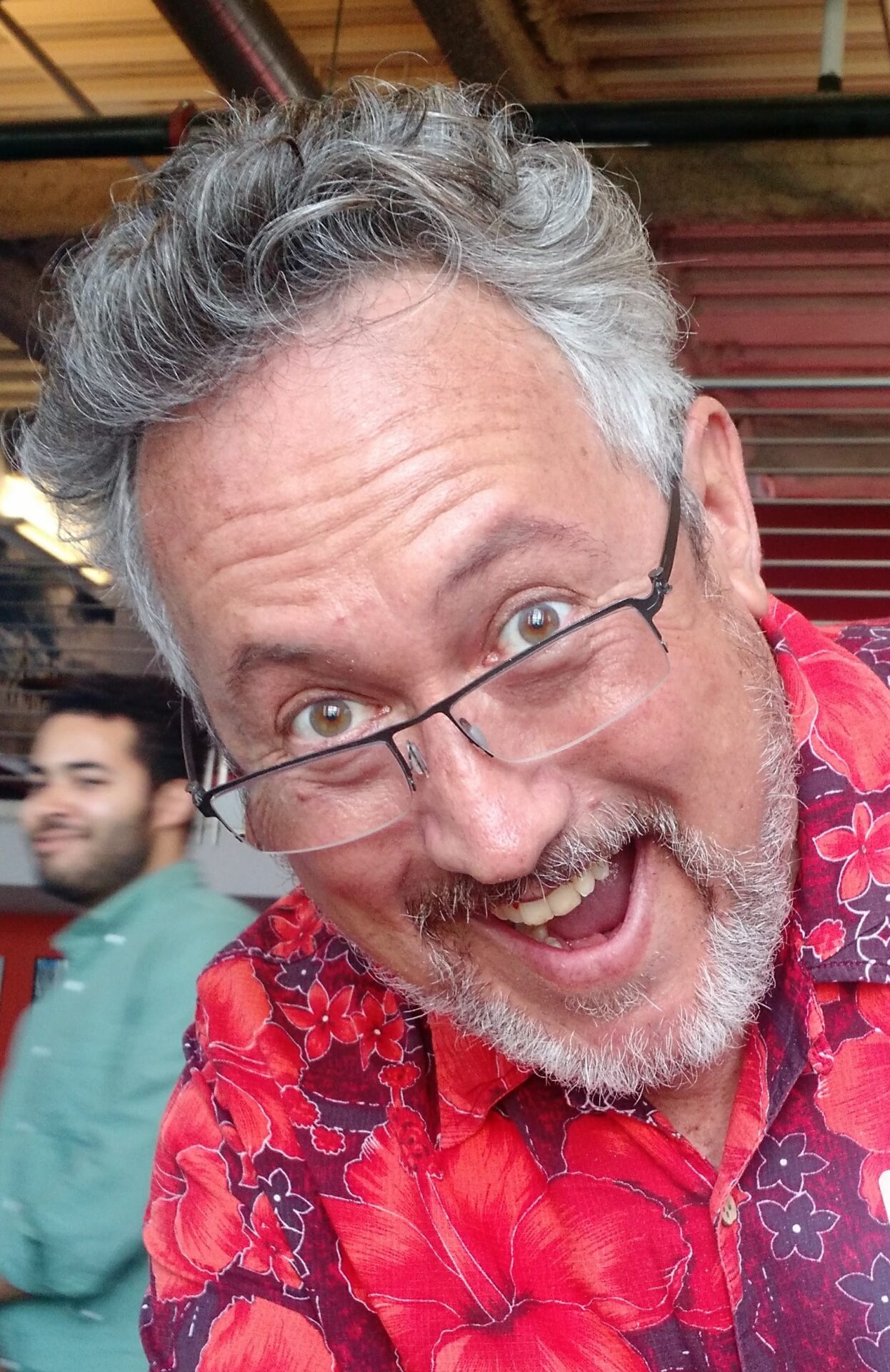 Stuart Mangrum
Stuart Mangrum
